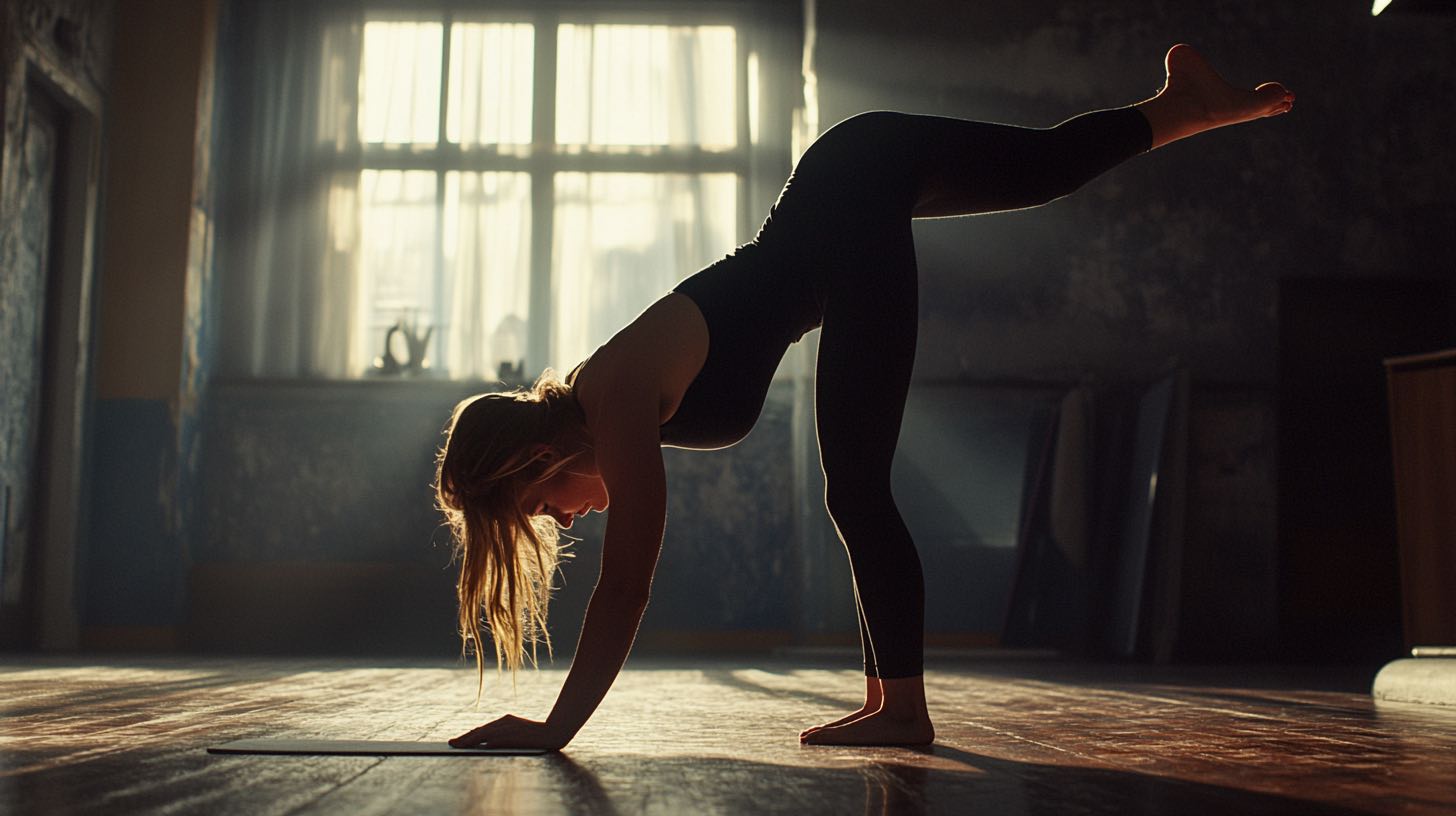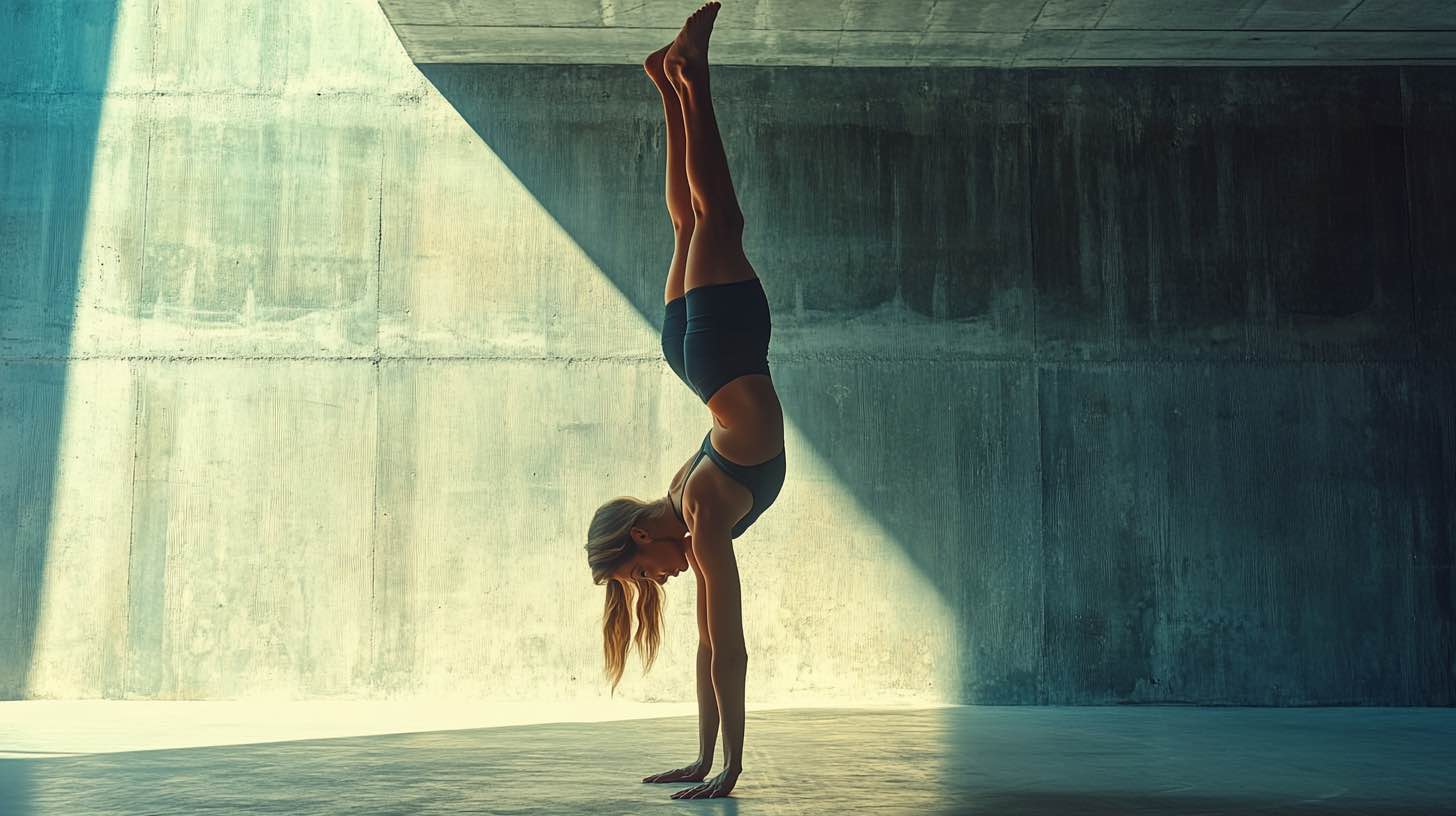Sep 16
Are you ready to practice your handstand and improve your handstand training?
To new heights?
In this article you will find practical tips to master the art of the handstand like a pro!
Whether you're an experienced yogi looking to perfect your inversions or a newbie to the world of handstands, we've got you covered, from alignment to building strength and balance.
With these tips and tricks you will overcome gravity in no time.
I. Learning to do a handstand means understanding balance
To be able to perform a handstand, it is important to understand the basic principles of balance.
Without this, you won't be able to do a stable handstand.
You know for sure that you can come to us at any time HIIT Boot Camp or in the Pilates come to work on your balance, right?
But that is only a side note.
Back to the topic.
The ability to master where to move the weight and how to control the core muscles is of great importance to the understanding and ability to do a handstand.
It's not about just throwing your feet up and hoping for the best to happen - it's a matter of concentration, practice and sometimes a good sense of humor, you will inevitably fall over a few times in the beginning.
So, if you want to learn handstand, you should stick to the basic principles.
With some practice and dedication, you will soon be able to stand upside down on your hands like a pro.
1.1. The importance of the core muscles
Another principle of balance in the handstand is the control of the core muscles.
By activating the rectus abdominis and lower back muscles, you can give the small of your back a more stable shape, making it easier to draw a straight line from the tips of your toes to the tips of your fingers while turning over.
The core muscles are the "core competence" in the handstand and core stability is the most important thing to prevent you from falling over when attempting a handstand.
Without strengthening your core muscles, you will almost inevitably stumble against the wall with big steps when doing a handstand (ouch).
So if you want to learn handstand, focus your attention on activating the abdominal and Back muscles.
You might also want to create a carpeted area to be on the safe side, in case your handstand attempts fail.
If you practice diligently, sooner or later you will be able to master the handstand without any embarrassing slips!
1.2. The correct weight distribution
If you want to learn a handstand, you not only have to activate your core muscles, but also master the correct handling of weight distribution.
After all, you don't want to fall forward or tip backwards like a seesaw.
The goal is to find the optimal point where your body weight is evenly distributed between your fingers and the palm of your hand.
If you put too much weight on the balls of your hands, you will roll backwards!
If you lean back too far, you will roll forward.
So pay attention to the perfect Balance point and land standing!
1.3. Patience and perseverance
However, if you want to master a handstand, you have to be patient and practice persistently, because after all, good body tension is only one thing, correct hand position is another.
You must combine the two, while channeling the two core principles hand in hand (pun intended) in the right direction so that you can ultimately put your handstand goals into action.
Remember: Rome wasn't built in a day, and neither was your handstand.
So stick with it, be patient and most importantly, have fun.
With dedication and patience in handstand training, you can soon get back into a horizontal position like a pro.

II. Strengthening the core muscles for more stability during handstands
To master the handstand in no time, you should first concentrate on the strength of your core muscles, which is essential to ensure sufficient stability in this challenging posture.
Without well-developed core muscles, you will no longer have solid ground under your feet, but will be as wobbly as a newborn giraffe searching for balance.
But no matter how you look at it, a giraffe has to find its balance in order to stand safely, and so do you if you want to do a handstand.
2.1. Strengthening the core
To do this, you not only need to strengthen your core, but also have good handstand grips.
For example, if you are clinging to the ground "like a starving buffalo catching the last slice of cheese," it is important to perform the handstand at the center of your body and with firm grips.
Work on your core, practice correct handstand grips and you'll soon be standing on your hands like a real pro!
2.2. Tension in the middle of the body
In addition, it is crucial to work on tension in the core to better maintain balance and relieve the strain on your lower back so that you do not fall over when you finally do the handstand.
So respect your core and it will not only keep you safe and confident over the table, but will also save you from unpleasant situations in which your handstand could be your downfall.
Speaking of core - after a week of training with us you will find it in one of our Retreats 😉
2.3. The art of lifting
Get a reasonable grip on your core muscles and learn the art of pushing yourself up high on the ground.
Not only does such exercise improve balance and stability, but it also strengthens the entire core muscles, which are essential for performing handstand push-ups.
If you do these basic movements regularly, you will gain the strength and control needed to hold a perfect handstand.
2.4. The benefits of regular handstand practice
So don’t neglect your core muscles, because they are the key to the secrets of the perfect handstand.
If you include these exercises in your daily training, you can not only improve your form and balance, but also your core muscles, your poor and strengthen and stabilize shoulders.
Once you have mastered the handstand, you can not only impress those around you, but also benefit from the improved strength and stability of your entire body.
The next time you burst out doing a handstand, you can confidently stand with a straight back and show off your dazzling skills from all angles!
Handstand Workshops
Learn how to do a handstand correctly in a workshop.
III. Practice of correct placement and alignment of hands
Before you start the handstand, you should be clear about the correct hand position.
With your hands shoulder-width apart, you have a more stable base to support your body weight.
This step is important to help you master this impressive human ability.
Remember: Rome wasn't built in a day, so practice and take the time you need to achieve the perfect handstand.
If you bring a strong hand position, a focused mind, and unwavering determination as you embark on this challenging journey to handstand, I believe you are on the right track.
3.1. Importance of hand position for stability
Proper alignment is key to maintaining balance during handstand training.
Aligning the hands directly under the shoulders and spreading the fingers further apart are crucial for even weight distribution and avoiding pain in the wrists.
Imagine you are about to lay the foundation for your headstand masterpiece.
A well-built house requires a strong foundation, and handstands also require solid alignment to remain upright and stable.
So next time you try a handstand, keep these little things in mind.
3.2. Importance of precision in hand placement
If you pay close attention to the accuracy of hand placement and alignment, you can improve the overall handstand exercise.
Consistency in the specific elements leads to greater control and stability in the posture and ultimately to more confidence and progress in the handstand.
But remember, a good handstand can only come from a good foundation; so focus on the details and watch your skills start to grow.
So keep practicing to perfect the basics of learning to do a handstand, because soon you will be able to jump into a handstand like a pro!
3.3. Learn the correct handstand technique
The first place to go when it comes to learning how to do a handstand is the section Learning How to Do a Handstand.
No matter whether you have already mastered the art of balanced handstands or would like to practice the form of handstands: Here you will find everything you need to learn handstands.
Whether you are a beginner who wants to do your first handstand or a professional who wants to take their performance to a whole new level:
With step-by-step instructions, expert tips, and a community of handstand enthusiasts, you'll be able to do handstands in no time and love them.
So why hesitate? Enter the world of handstands and join in today!
3.4. From a strong core to a safe handstand
A particularly important point is addressed in the category "Strengthening core muscles for better balance" during handstand training.
Those who focus on exercises that address the core of the body, for example Planks, leg raises, or Russian twists, will help improve overall stability and control when attempting a handstand.
Because: A strong core not only improves balance, but also helps prevent handstand training injuries.
Why: Do not eliminate exercises to strengthen the core muscles from your handstand trainer repertoire, because without the counterpart of a stable core you will get poor results and will not be able to do your handstand.
3.5. Core strength for handstand beauty
If you want to perfect the handstand down to the last detail, you need strong core muscles.
When you activate your abdominal muscles during a handstand, you not only show off your muscles, but also your stability and sense of balance, like a builder.
What else can I say about handstand push ups - they take your handstand game to a new level!
So don’t forget to tighten your core and confidently demonstrate your impressive handstand technique.

IV. Learn how to get into a handstand correctly
In order to safely attempt to stand up in a handstand, body alignment and weight shifting are crucial.
By properly positioning your arms and contracting your core as if you were in a planking contest, you can create a stable base for your upside-down balancing act.
Remember that a stable core is the most important thing to conquer gravity like a boss.
So, the next time you work on your handstand, remember: keep these two things in mind and you'll be standing boldly on your hands pretty soon.
4.1. The importance of correct alignment when climbing into a handstand
Practice controlled kicks against the wall to increase confidence and strength in your shoulders and core before attempting freestanding forms.
With this step-by-step approach, you can gain control while minimizing the Risk of falling over.
Remember: Rome wasn't built in a day, and the perfect handstand isn't achieved in one day, either.
If you focus on the little things about the handstand, you too can build up the alignment for the handstand.
So if you want to do the dancing upside down against the wall, take a step back, push yourself off the wall and calmly build up strength and control through individual kicks.
4.2. Build discipline and control through step-by-step training
It should also be noted that mastering the handstand is a matter of time and practice.
By concentrating on maintaining a body line from the wrists to the hips and using the hand and leg muscles, control can be gained over the force with which the handstand is held.
Consistency and patience are beneficial in order to be able to roll backwards safely and confidently.
That's why you shouldn't give up and feel discouraged if things don't work out right away.
In any case, a strong will and conscientiousness can help you to gradually descend like a pro!
4.3. Patience and consistency in handstand training
Patience and consistency play a crucial role when learning the handstand.
Despite slow progress, you should not hold back.
A slow approach to a large target strengthens control and thus balance, which is essential in a handstand.
So let's start again and again from the beginning, because the most convincing thing is that in the long run you will achieve a result - step by step.

V. Wall as an aid for handstands
Let us reach for these walls to support ourselves and move forward:
When we learn to do a handstand, walls can be used as support points to give us stability and orientation.
First, try handstand training, for example, standing with your back against the wall.
The feet of the back wall only lightly touch the wall to stabilize their standing position.
This way, you can concentrate on maintaining your balance without being mentally or physically intimidated by the threat of falling over.
Even if, despite all your care and effort during handstand training, you feel like you are going to fall, make sure that you have the wall at your back, literally!
So don't be afraid to think of the wall as close as possible to find out what works on your way to perfecting your handstand.
No matter: practice makes perfect, and if you hit the wall a few times, it doesn't matter!
5.1. Support wall: Gaining trust
If you decide to do handstand training, you have come to the right place!
Doing handstand training is not without its problems, but it is incomparably rewarding.
The skills required are strength, balance and determination.
Fear? For heaven's sake! With the right instruction and lots of repetition, that's a life in no time.
As mentioned above, Rome wasn't built in a day, and handstand skills don't become useful and attractive overnight.
So keep at it, don't let a few falls unsettle you and you will soon be able to proudly demonstrate your handstand skills to your friends with confidence.
Don't forget to breathe carefully, tighten your abdominal muscles and have a lot of fun while practicing.
After you have done your handstand, you can then do the Ice bathing at Templeshape to relax your muscles.
5.2. Progress through gradual detachment from the wall
As long as you have completed the basic training with the initial familiarity with the wall on which you can always support your hands in a handstand, feel encouraged to give your handstand game a different direction and to move the barriers as slowly as possible.
Make an effort to gradually increase your own standing position at as great a distance from the wall as possible in order to acquire more body tension and the will to balance, both physically and mentally.
This progression not only targets the muscles of the core, but also refines your ability to maintain true balance without relying on external support.
It's like extending the handstand into the world of grandeur - your confidence and resilience grow with every inch you move away from the wall.
So really dare to surrender to the reservations that will take you to another world, far away from the safety net and into the world of the true balance masters.
5.3. Completing the handstand with wall support
When attempting handstands against the wall in the future, you should actively tense your whole body and press your shoulders and arms against the floor to form a straight line from your torso to your hands.
Ultimately, the wall will act as an additional safety net when it comes to adding a new, challenging movement to your range of options.
This allows her to improve some of the essential elements of a "real" handstand and prevent mistakes.
Here is the wall to believe in yourself until you break the handstand or get angry, or to claim the new "height".
If you stick with it, you will soon find that you can feel comfortable doing handstands like a pro.
5.4. Challenges and discoveries when learning to do handstands
Learning to do handstands can be an unconventional adventure.
From jumping against the wall to almost falling over on the floor, a range of amusements are possible.
With a good dose of determination and some effort, it is worth pursuing the art of the handstand.
The persistent beginning with factors such as shoulder girdle strength and abdominal stability and the slow introduction to the movement of hand balancing turns out to be as frightening as it is rewarding.

VI. Develop consistency through regular practice
Consistency is key when learning to do a handstand.
No matter whether you invest five or fifty minutes a day, you will gradually build up the necessary strength and muscle memory to actually be able to hold the position.
So, think of your daily handstand workout as a small, neat project that you will have a lot of fun doing and through which you will learn the art of the upside down position.
So, take your Yoga mat under your arm, choose a solid wall as a support and prepare yourself to turn your view around one day, so to speak.
As we all know, Rome wasn't built in a day, and you can say the same about your handstand practice.
Stick with it, pull yourself together, and take care of yourself a little, and before you know it, you'll be performing like a circus performer.
6.1. Keyword muscle memory and endurance
Regular exercise not only improves your physical strength, but also your balance and proprioception, i.e. your body awareness.
And so, with appropriate training, it will be easier for you to maintain the handstand position for a certain period of time.
If you work on your handstand poses with unwavering loyalty, you will eventually gradually master both the corresponding Muscle memory as well as building up the stamina necessary to succeed with your headstand every time, precisely and with real ease.
As we all know, Rome wasn't built in a day, so loosen up a bit when it comes to teaching your body and mind a new, challenging, but no less fun skill.
Keep working on it and make sure that you can soon build up your handstand with your hands like a real maneuver expert.
6.2. From supported handstand to freestanding handstand
If you continue to put time and effort into handstand mastery exercises, you will soon notice differences in your technique and balance.
Gradually, you will no longer need to rely on the wall for support when practicing the handstand, as you will have the strength and skill required to do it without the wall, i.e. as a freestanding handstand.
With each practice, you will become more confident and stronger in this challenging pose, ultimately leading to a sense of accomplishment and mastery.
So keep up your effort and patience and plan now to amaze everyone around you with your great handstand practice!
6.3. Patience and regular practice as the key to success
Patience is key if you want to take your handstand practice to the next level.
Each training session, whether short or long, helps to refine your body's awareness in the air, accelerate the response of the nervous system and improve your balance function.
Regular practice means challenging yourself a little more every day, trying out new variations and celebrating even the smallest progress as a success.
Don't be discouraged if you experience a setback - they are part of the learning process.
With consistency and a clear goal in mind, you will experience the sense of achievement of mastering this much-admired handstand technique.
6.4 The uplifting character of small steps forward
Every bit of progress, whether it's holding a handstand for one more second or finding the right balance without help, is a step toward success and boosting your self-esteem.
These expressed partial successes motivate you to continue and not deviate from your goal.
Understand how far you have come and use this progress as the motivation you need to achieve even more.
Every day you practice handstands brings you closer to your dream, and that is the true meaning of effort and sacrifice.
So don't give up, stay persistent and remember that the perfect handstand position is only a few moments away.
tags

